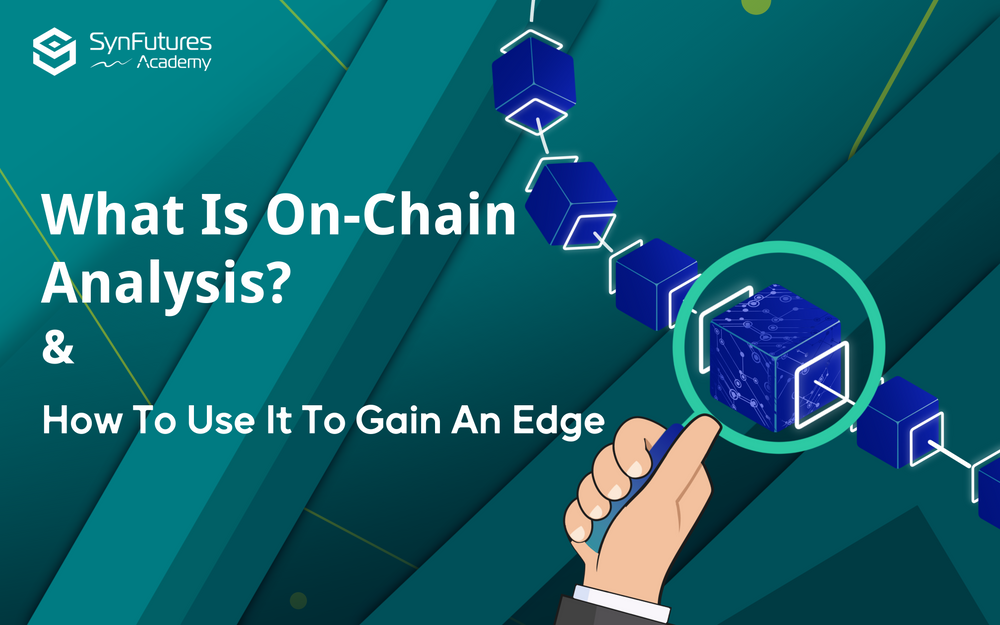What is On-Chain Analysis & How to Use It to Gain an Edge
Overview
In traditional finance, traders and investors use technical and fundamental analysis to gain an edge over the market. Technical analysis is performed using indicators like price, volume, and momentum while fundamental analysis is performed using metrics like P/E ratio, Earnings per Share, EBITA, and others. In the crypto ecosystem, technical analysis works the same, but the fundamental analysis is vastly different. This is because the metrics used for the fundamental analysis of companies are often not applicable to cryptocurrency projects. That’s where on-chain analysis comes in.
On-chain Analysis
On-Chain Analysis is the process of evaluating the underlying strengths and weaknesses of a crypto project by looking at the transactions that are happening on the network. Public blockchains are transparent by design. Every transaction executed in the network is recorded on the blockchain for all posterity. Anyone with a block explorer can access these data and use them to understand how the blockchain functions. Think of it as opening the hood of a car to look at how the engine is running. It might look daunting at first but understanding how good the engine is will give you a far better idea about the total worth of the car. The same also applies to cryptocurrency projects.
Let’s look at an example: the charts below show the daily transaction volume on the Ethereum network from Jan 2020 – Jul 2022.
As we can see from the chart, the number of transactions steadily increased from January 2020 and peaked around May 2021. After that, it largely moved sideways up until July 2022 when the activity spiked again due to the anticipation of the upcoming Merge. Now let’s compare this with the price chart of Ethereum during the same period.
Unlike the transactions, the price was moving largely sideways until 2021 when it witnessed a massive increase, followed by a sharp decline in 2022. In July 2022, the price chart shows ETH is down 70% compared to its previous high, while the activity chart shows the Ethereum transaction number is almost back to its high.
Anyone who is just looking at the price chart would miss this important data point. This is the real advantage of on-chain analysis: it allows the users to see past the price and look at the fundamentals of a crypto project.
How to Access On-chain Data
All public blockchain networks come with an explorer that allows users to access the data recorded on them. The previous Ethereum transaction chart was taken from the Etherscan explorer. This explorer allows users to see a variety of information about the Ethereum network including market data, blockchain data, miner data, and much more.
Unfortunately, there is no uniformity in how the explorers look and what data they present, so each project’s explorer will have a unique look and format. It’s necessary for users to spend time familiarizing themselves with the explorer so that they can better benefit from the information they provide.
There are also several third-party sites that provide a more in-depth analysis of on-chain data. Some of the popular ones are Glassnode, Cryptoquant, Dune, and Messari. Most of these services have both paid and free tiers with paid tiers offering more granular data. However, even the free tier often contains extremely useful information that can help someone better understand a project. Below is an example of a Glassnode chart that shows the revenue earned by Bitcoin miners since 2015. More details can be found here.
Using On-chain Analysis to Gain an Edge
Now that we have a fair bit of understanding about on-chain data and blockchain explorers, let’s look at how we can use this data to gain an edge over the market.
Because on-chain data shows us everything that’s happening in the network, we can use it to understand the health of the network and the mood of the people holding the token. Let’s look at some of the popular metrics that are calculated using on-chain data.
- Whale Watching: On-chain data is used to analyze how crypto whales behave during the price rise and price fall. If whale wallets start buying heavily during a bear market, that indicates that they believe the price may be close to its bottom out and started accumulating. Similarly, if a lot of whale wallets start selling their tokens when the price is rising, it indicates that the price might be about to top out.
- Number of coins in the exchange: Most long-time hodlers would move their coins out of the exchange right after purchase and would only bring them back to an exchange if they plan to sell them. So, fewer coins on the exchange wallet indicates more hodlers are buying the coin and moving them out to their private wallet which is a bullish sign. Conversely, more coins on exchange wallets mean they’ve sent their tokens to exchanges from their private wallets and plan to sell them. That’s considered a bearish sign.
- Number of Active Wallets: Active wallets are a good indicator of how many people are actively participating in the network. If the number of active wallets witnesses steady growth that means the project is gaining adoption and therefore it’s considered a bullish sign. But if the number of active wallets remains stagnant or decreases that’s a bearish sign and indicates the project is not gaining adoption.
- Staked Percentage: All proof-of-stake cryptos allow their tokens to be staked and most of them even have an unlock period before staked tokens can be moved elsewhere. Because of this, most people will only stake their coins if they believe the project will succeed in the long run. So, if a project has a large portion of its coins staked that indicates the community has a high level of confidence in its success.
- Network Value to Transaction (NVT) Ratio: This metric was created by Willy Woo. It monitors the ratio between market capitalization and transaction volume. If NVT is high, it means the price is outpacing the value of the network which is a bearish sign. If NVT is low that means the price is falling behind the value of the network which is considered a bullish sign.
These are only a few examples of on-chain analysis metrics. Such metrics are invented constantly as the crypto community finds better ways to interpret the data available on the network.
Limitation
While on-chain analysis can be a great tool for investors and traders, it’s not without its limits. It’s important to know its limitations in order to use it more effectively. So, let’s look at a few of them below:
- Layer-2 is not covered: As the blockchain ecosystem develops new methods of processing transactions like Layer-2 and cross-chain functionalities, on-chain analysis on one chain may not be enough to understand the true value of the network. For example, an on-chain analysis of Ethereum will only show the number of transactions that are taking place in the Ethereum network itself but not the billions of dollars worth of transactions that are taking place in Ethereum L2s and Sidechains. These chains depend on Ethereum and add value to it, so on-chain analysis of the Ethereum network may only provide a partial picture of its total value.
- Rapidly changing technology: As the blockchain field is evolving at a breakneck pace, it’s likely that some of the metrics that are accurate today may become obsolete tomorrow. For example, we learned earlier that the number of coins in exchanges is one of the metrics that are used to gauge the mood of the crypto community. But this metric is less accurate today than it was 2–3 years ago because of the emergence of DeFi. Three years ago, hodlers who wanted to sell their tokens had to move them to an exchange as there was no other way to sell them. However, today hodlers can sell directly from their private wallet using a decentralized exchange without moving them to any exchange wallet. In the future, if we reach a stage where almost all the trading is taking place in DeFi, then this metric will become obsolete.
As with everything else in crypto, on-chain analysis constantly evolves; new metrics are invented, and older metrics are refined or rejected. But despite this constant change, one thing is certain - on-chain analysis is one of the key methods for evaluating the true value of a crypto project and will continue to be used both by individuals and institutions looking to discover the next crypto gem.
Discover SynFutures' Crypto Derivatives products: www.synfutures.com/.
Disclaimer: SynFutures Academy does not guarantee the reliability of the site content and shall not be held liable for any errors, omissions, or inaccuracies. The opinions and views expressed in any SynFutures Academy article are solely those of the author(s) and do not reflect the opinions of SynFutures. The SynFutures Academy articles are for educational purposes or information only. SynFutures Academy has no relationship to the projects mentioned in the articles, and there is no endorsement for these projects. The information provided on the site does not constitute an endorsement of any of the products and services discussed or investment, financial, or trading advice. A qualified professional should be consulted prior to making financial decisions.




